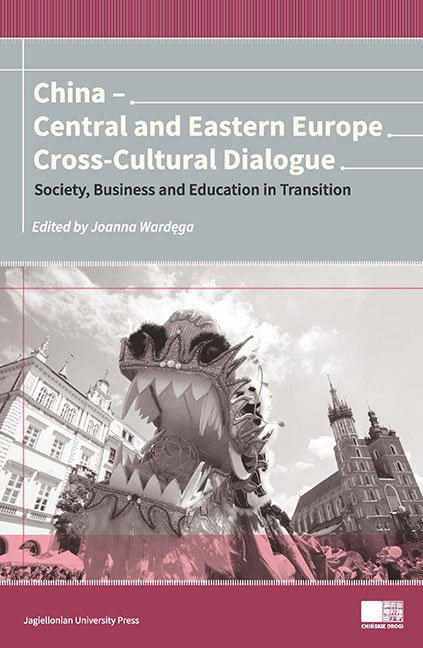Book contents
- Frontmatter
- Contents
- Foreword
- PART I Society and Culture in Transition
- PART TWO Economy and Markets in Transition
- PART THREE Education in Transition
- Opening the Two-Way Fast Lane for China-CEE Cultural Exchange by Equally Valuing the International Promotion of the Chinese Language and the CEE Languages Teaching
- A Contrastive Analysis of Traditional Chinese and Western Teaching Styles – A Case Study
- How Does Learning Style and Teaching Style Jointly Relate to Cultural Intelligence? A Study of Chinese Overseas Students
- Preparation of University Students from Western Cultures for Cooperation with China: Reasons and Methods
- Facing the Challenges of Teaching Chinese through Confucius Classrooms in Slovenian Schools: Current Situation and Prospects
- The Role of the Confucius Institute at Ss. Cyril and Methodius University in Skopje in Promoting the Chinese language, Culture and Business in the Republic of Macedonia
- Education in Transition of China-Based Jesuits from the Austrian Province
- Link in the History: The Development of the Research on Avguštin Hallerstein and its Contemporary Meaning
- Contributors
Opening the Two-Way Fast Lane for China-CEE Cultural Exchange by Equally Valuing the International Promotion of the Chinese Language and the CEE Languages Teaching
from PART THREE - Education in Transition
Published online by Cambridge University Press: 22 December 2017
- Frontmatter
- Contents
- Foreword
- PART I Society and Culture in Transition
- PART TWO Economy and Markets in Transition
- PART THREE Education in Transition
- Opening the Two-Way Fast Lane for China-CEE Cultural Exchange by Equally Valuing the International Promotion of the Chinese Language and the CEE Languages Teaching
- A Contrastive Analysis of Traditional Chinese and Western Teaching Styles – A Case Study
- How Does Learning Style and Teaching Style Jointly Relate to Cultural Intelligence? A Study of Chinese Overseas Students
- Preparation of University Students from Western Cultures for Cooperation with China: Reasons and Methods
- Facing the Challenges of Teaching Chinese through Confucius Classrooms in Slovenian Schools: Current Situation and Prospects
- The Role of the Confucius Institute at Ss. Cyril and Methodius University in Skopje in Promoting the Chinese language, Culture and Business in the Republic of Macedonia
- Education in Transition of China-Based Jesuits from the Austrian Province
- Link in the History: The Development of the Research on Avguštin Hallerstein and its Contemporary Meaning
- Contributors
Summary
Languages are the bridges of communication and exchange across different cultures. Demands for Chinese talents in foreign languages, especially translators can date back to the pre-Qin period (before 221 B.C.). But judging by the will and the methods of communication, the communication between China and the outside world had been unidirectional in the long historic period, after Zhangqian went to the west of China on a diplomatic trip. The Chinese rarely show interest in exploring the outside world. There were only a limited number of professionals in foreign languages and they were not influential. The bridge of languages wasn't a two-way street. Like Professor Ge Jianxiong said, the famous Silk Road “is not built or promoted by Chinese. The Silk Road cannot take form without foreign demands for Chinese silk” (Ge, 2015). The overseas communication of Chinese culture was also led by foreigners in the beginning: in the 5th year of Dazhong in Tang Dynasty (851 A.D.), the “Travel notes in China and India” by the Arabian Suleyman are the first books introducing Chinese culture to Westerners. Then Marco Polo, Matteo Ricci, Michal Boym, George Macartney, Nicolae Spataru Milescu and others went to China in different ways. They all wrote books or travel notes. But not all of them were experts in Chinese language.
After the Opium War of 1840, the Chinese wanted to see the world. This wish became more stronger than ever before. Their demand for talents in foreign language kept on rising. A number of great translators turned up in the Republic of China period (1912–1949). They translated classic literature of different countries into Chinese. At that time, the culture of communication between China and the foreign countries was still mainly unidirectional, it was just the direction that had changed. It was only possible after entering into this new century, to promote Chinese language and culture, while cultivating talents in foreign languages to realize two-way fast passing of Chinese and foreign languages on the bridge of culture exchange.
The history of building a two-way passage between Chinese and the CEE cultures
After the People's Republic of China was founded, it was first recognized by former Soviet Union and the other CEE (Central and Eastern Europe) countries.
- Type
- Chapter
- Information
- China - Central and Eastern Europe Cross-Cultural Dialogue Society, Business and Education in Transition , pp. 317 - 326Publisher: Jagiellonian University PressPrint publication year: 2016

